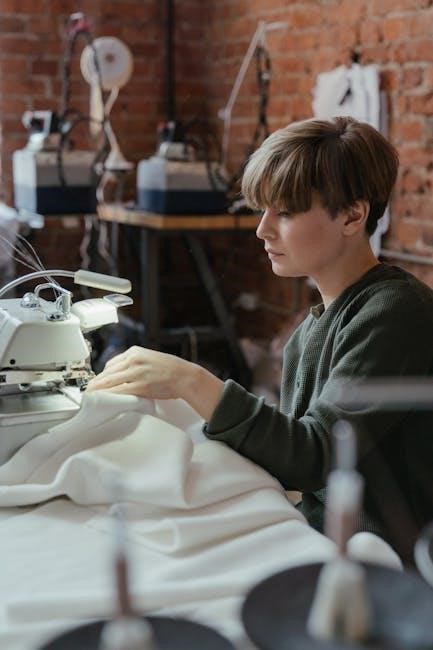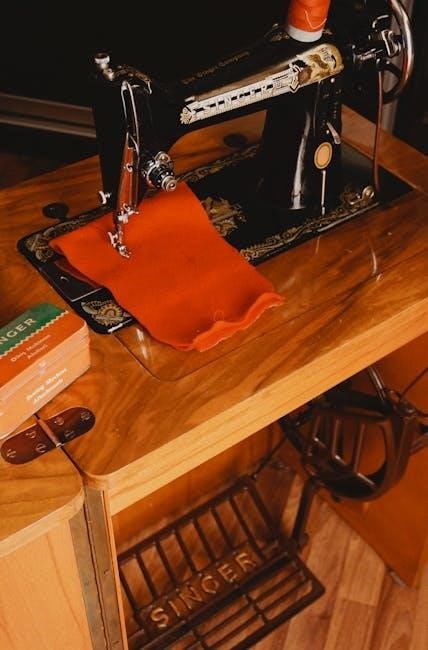The Singer Simple Sewing Machine Manual provides guidance on operating and maintaining the machine, with
- step-by-step instructions and troubleshooting tips for common issues, helping users to sew efficiently and effectively always online.
Importance of Reading the Manual
Reading the Singer Simple Sewing Machine Manual is essential for optimal performance and to prevent damage to the machine. The manual provides valuable information on the proper use and maintenance of the machine, including threading, tensioning, and troubleshooting. By following the instructions in the manual, users can avoid common mistakes and ensure that their machine runs smoothly and efficiently. The manual also includes important safety precautions and guidelines for handling and storing the machine. Additionally, reading the manual can help users to understand the different features and functions of the machine, allowing them to take full advantage of its capabilities. Overall, reading the manual is crucial for getting the most out of the Singer Simple Sewing Machine and for ensuring a positive sewing experience. With the manual, users can confidently operate the machine and create high-quality sewn projects. The manual is a valuable resource that should be consulted regularly.

Troubleshooting Common Issues
Troubleshooting common issues with the Singer Simple Sewing Machine requires patience and attention to detail always using online resources.
Thread Related Problems
Thread related problems are common issues that can occur with the Singer Simple Sewing Machine, including thread breakage, tangling, and uneven tension. To resolve these issues, it is essential to use high-quality thread, such as German made Gutermann, and to ensure that the thread is properly threaded through the machine. The thread should be inserted through the tension disks and guided through the machine correctly. Using cheap thread can cause tension problems, and it is recommended to use all-purpose thread. Additionally, the thread should be wound correctly onto the bobbin, with a medium speed winding, especially for poly thread. The bobbin should be inserted into the bobbin case in the correct direction, and it is crucial to use the correct bobbin for the machine. By following these guidelines, users can minimize thread related problems and ensure smooth sewing. Regular maintenance, such as cleaning and oiling the machine, can also help to prevent thread related issues.
Bobbin Winding and Installation
Proper bobbin winding and installation are crucial for smooth sewing with the Singer Simple Sewing Machine. The bobbin should be wound at a medium speed, especially when using poly thread, to prevent uneven winding. It is essential to wind the bobbin correctly to avoid thread related problems. The bobbin should be inserted into the bobbin case in the correct direction, and users should ensure that they are using the correct bobbin for their machine. A incorrectly wound or installed bobbin can cause stitch problems, thread breakage, and uneven tension. To wind the bobbin, users should thread the machine with the presser foot up and then insert the bobbin into the bobbin case. The bobbin should be seated properly, and the thread should be pulled gently to ensure that it is not too loose or too tight. By following these steps, users can ensure that their bobbin is wound and installed correctly, allowing for smooth and efficient sewing. Regular checking of the bobbin for nicks, dents, or other damage can also help to prevent sewing problems.

Proper Threading and Tensioning
Thread the machine correctly, adjusting tension with presser foot down, using high quality thread for optimal results always with Singer machines and following manual guidelines.
Needle Selection and Maintenance
The selection and maintenance of needles is crucial for optimal sewing performance. According to the manual, Singer machines require Singer needles, which have a slightly thicker shaft. For European machines, Schmetz needles are recommended, while Brother machines also use Schmetz needles. It is essential to choose the right needle for the type of fabric being sewn, as different fabrics require specific needle types. For example, denim and thick fabrics require heavy-duty needles, such as size 14-16, while stretch knits and jersey require ball point or stretch needles. Microtex or sharp needles are suitable for wovens, silk, and light poly fabrics. Regular maintenance of needles is also necessary, as bent, nicked, or dull needles can cause sewing problems. Needles should be replaced frequently to ensure optimal sewing performance. By following these guidelines, users can ensure that their sewing machine is running smoothly and producing high-quality stitches. Proper needle selection and maintenance can help prevent common sewing issues and extend the life of the machine.

Lubrication and Machine Care
Regular lubrication with sewing machine oil or TriFlow is necessary to keep the machine running smoothly and quietly always with proper maintenance and care online every day.
Choosing the Right Thread and Needle
To ensure optimal sewing performance, it is essential to choose the right thread and needle for your project. The type of thread and needle used can greatly impact the quality of the stitch and the overall appearance of the fabric. For general sewing, an all-purpose thread such as Gutermann, Clark, or Mettler is recommended. These threads are made from high-quality materials and are designed to work well with a variety of fabrics. When it comes to needles, it is important to choose a needle that is suitable for the type of fabric being sewn. For example, a denim needle is best for sewing thick fabrics like denim, while a sharp needle is better for sewing delicate fabrics like silk or cotton. By choosing the right thread and needle, you can ensure that your sewing projects turn out professional and polished. Using the right thread and needle can also help to prevent common sewing problems like thread breakage or uneven stitches.

and Additional Resources
For more information, visit the official Singer website or online forums for additional sewing machine resources and troubleshooting guides always available online now.
Final Tips for Optimal Sewing Experience
To achieve an optimal sewing experience, it is essential to regularly maintain and clean the machine, as well as use high-quality threads and needles. The
machine’s user manual provides guidance on the proper use and maintenance of the machine. Additionally, using the correct type of thread and needle for the specific fabric being sewn can greatly impact the quality of the stitches. It is also important to keep the machine well-lubricated and to avoid overloading it with too much fabric. By following these tips and taking the time to properly care for the machine, users can ensure a smooth and efficient sewing experience. The official Singer website and online forums also offer a wealth of information and resources for users to improve their sewing skills and troubleshoot any issues that may arise. With proper care and maintenance, the Singer Simple Sewing Machine can provide years of reliable service.

Leave a Reply
You must be logged in to post a comment.